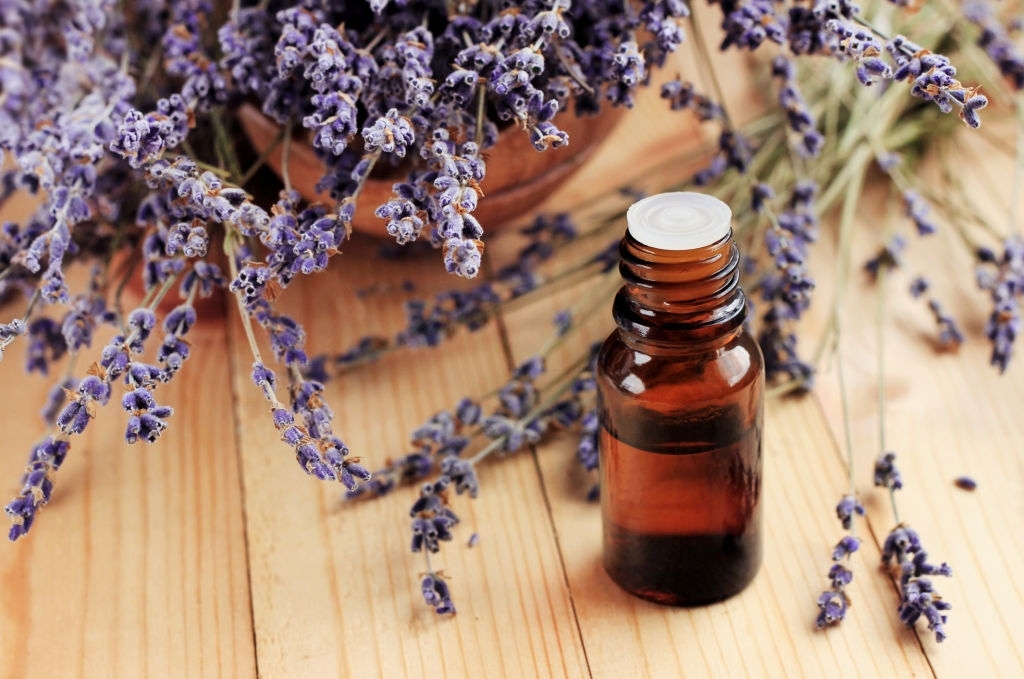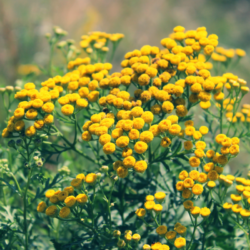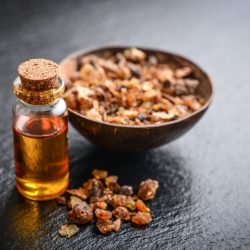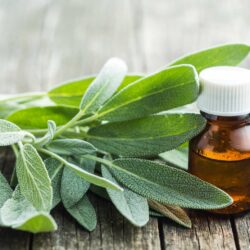Spike lavender, whose botanical name is Lavandula latifolia spica, belongs to the Lamiaceae family. Its essential oil is obtained by distilling its flowers (flowering tops).
Botanical description
Spike lavender is a larger sub-shrub than fine lavender, reaching up to 75 cm in height. It is made up of straight, numerous branches, usually branched, bearing long, spatulate, opposite, silvery-green leaves. Its flowers, in terminal spikes of purplish-blue (sometimes white), bloom from June to September. Sensitive to the cold, spike lavender thrives at moderate altitudes (300 to 700 m). In its natural state, it is found in the garrigue, on dry, stony soils of southern France and southern Europe.
The name “aspic” for this variety of lavender derives from its reputation for curing the bites of the asp viper. It flowers and is harvested later than true lavender. Preferring dry limestone soils, it grows at a lower altitude, between 200 and 500 metres. Various hybrids between this species and true lavender have resulted in varieties of lavandin, such as Lavandula x burnati clone super.
Spike lavender flowers give off an exquisite fragrance that is a delight to bees. Lavandula comes from the Latin lavare, to wash, as it was used to flavour baths and washing powder. It has been used to make eau de Cologne since the 16th century, and is also a component of many of today’s perfumes. Lavender was also famous among the Greeks and Romans for perfuming and disinfecting thermal baths.
A little history
Ancient times
Lavender was famous among the Greeks and Romans for perfuming and disinfecting thermal baths.
The Greeks called lavender stochas, probably because butterfly lavender was their favourite. Pliny, in Latin, refers to pseudo-nardus or false spikenard, another vernacular name for spike lavender. But neither the Greek stochas nor the Roman pseudo-nardus allow us today to know which plants they really were.
Middle Ages
In the 9th century, the famous scholar Rhazes, an Iranian by birth, recommended fumigating hyssop, thyme and lavender against the plague, as did Hippocrates in his day. However, given the range of lavender aspic, it is doubtful that it was found in the Near East. These fumigations were also recommended by the Grand Albert to purify the surroundings of houses and living rooms.
Ibn al-Baytar (13th century) recommended spike lavender in Arab-Persian medicine as a fumigant to combat unpleasant odours, as an oral remedy for liver and spleen damage, and to help women conceive by warming the womb. It was also reputed to treat asp viper bites in hunting dogs and humans.
But let’s stay a little closer to the troubled Middle Ages. In her Physica, Hildegarde mentions lavender in two places. In the first, she calls Lavandula a plant whose scent “clears the sight, for it has the strength of the most powerful aromas and the usefulness of the most bitter: this is why it stops a certain number of illnesses, and also ward off evil spirits”.
In the 14th century, Jean de Gaddesden announced the diuretic virtue of lavender, which he described as specific for dropsy. So when Schroder, in 1665, wrote that spica was sovereign in curing nervous illnesses of psychic origin and that it calmed spasms, it was difficult to decide, since true lavender and spike lavender could both be used for these purposes.
Modern and contemporary times
Lavender has been used to make eau de Cologne since the 16th century.
In Europe, according to Cazin in the 19th century, lavender aspic is used to treat nervousness, digestive problems, bronchial congestion, asthma and rheumatism, particularly in the context of febrile illnesses. Applied topically, it acts as a tonic and resolver. Fournier (20th century) considers it to be a diuretic, cholagogue, carminative, antispasmodic and vermifuge when taken orally.
Valnet (20th century) recommends the essential oil for nervousness, insomnia and respiratory tract ailments, and as a topical treatment for wounds, ulcers, burns, eczema and insect bites. In Morocco, it is also used against lice and mites.
This is how reliable the data available on lavender aspic in the 19th and 20th centuries is. Cazin, Leclerc, etc. clearly distinguish between the three types of lavender known in France.
What are the pharmacological properties of the essential oil of Lavender aspic flowers?
The pharmacological properties of Lavender aspic flower essential oil are a subject of interest to health professionals and aromatherapy enthusiasts. This essential oil has unique medicinal properties that can help treat a variety of health problems. In this section, we’ll take a closer look at the pharmacological properties of this elixir made from Spike Lavender flowers.
Anti-inflammatory and analgesic properties:
Camphor has an analgesic and anti-inflammatory action when applied locally, and a rubefacient effect linked to vasodilatation of peripheral vessels. The anti-inflammatory action of 1,8-cineole has been demonstrated in vitro on white blood cells (monocytes) against inflammation inducers such as lipopolysaccharides or interleukin-1β.
Lavender aspic essential oil is also cortison-like in eczema. The analgesic effect of lavender aspic is induced in particular by linalool, which acts on muscarinic, opioid and dopaminergic receptors. It also acts on N-methyl-d-aspartate (NMDA) and glutamate receptors.
Expectorant and mucolytic properties:
These properties are due in particular to 1,8 cineole, which stimulates the exocrine glands of the respiratory mucosa.
Antispasmodic properties:
This effect is due to the action of 1,8 cineole on the smooth muscles of the trachea in relation to acetylcholine. However, linalool is also spasmolytic on intestinal and tracheal smooth muscles, probably by stimulating the enzyme adenylate cyclase, which increases cAMP.
Antibacterial and antifungal properties:
A mild anti-infective against staphylococcus aureus, lavender aspic essential oil is also immunostimulant, virucidal and fungicidal (active against fluconazole-resistant strains of Candida ). What’s more, its linalool-induced antiviral action shows strong activity against Adenovirus-2 (AVD-II), responsible for pharyngitis, pneumonia and gastro-enteritis.
Antianxiety properties :
The linalool contained in lavender aspic essential oil effectively inhibits glutamate binding in the cerebral cortex, interferes with glutamatergic transmission and suppresses the function of excitatory glutamate receptors by dose-dependent, non-competitive inhibition of [(3)H] MK801 binding (NMDA antagonist). In this way, linalool inhibits the release of acetylcholine and reduces the opening time of ion channels at the neuromuscular junction (blocking Na and/or Ca channels).
Other properties:
- Mild emmenagogue
- Tonicardiac
- Emergency essential oil for rapid relief and healing of severe burns and wasp stings
- Healing, vulnerary, antitoxic
- Antitumour, stimulates various cytokines: IFN-γ, IL-13, IL-2, IL-21, IL-21R, IL-4, IL-6sR, TNF-α, induces the Th1 type immune response, induces apoptosis
Does Lavender aspic essential oil require any precautions for use?
- For cutaneous use only
- Not recommended for pregnant (abortive) or breast-feeding women
- Beware of possible gynaecomastitising effects with prolonged use. Linalool inhibits the production of testosterone, to be avoided over the long term in males as an endocrine disrupter
- For adults only (risk of convulsion in children)
- Do not diffuse, inhale or put in bath water
- Use with caution by people suffering from auto-immune diseases, epilepsy, asthma, the elderly or Parkinson’s disease, as well as neurosensitive people
- Risk of neurotoxicity that may lead to epileptic seizures in high doses
- Do not swallow
- Not for internal use
- Interactions with essential oils containing more than 10% sesquiterpenes
- Not recommended for animals
- Avoid in combination with cortisone, risk of drug interaction, ask your pharmacist for advice
- Do not use over a prolonged period, as there is a risk of resting the pituitary-adrenal axis and suffering acute adrenal insufficiency if you stop taking the essential oil
- Avoid applying lavender aspic essential oil in the evening (or before any period of rest)
- Not recommended for people suffering from osteoporosis, due to the inherent risk of decalcification
Medical literature and clinical trials:
- Cavanagh HM, Wilkinson JM. Biological activities of lavender essential oil. Phytother Res. 2002
- Kuwahata H, Komatsu T, Katsuyama S, Corasaniti MT, Bagetta G, Sakurada S, Sakurada T, Takahama K. Peripherally injected linalool and bergamot essential oil attenuate mechanical allodynia via inhibiting spinal ERK phosphorylation. Pharmacol Biochem Behav. 2013
- Peana AT, De Montis MG, Nieddu E, Spano MT, D’Aquila PS, Pippia P. Profile of spinal and supra-spinal antinociception of (-)-linalool. Eur J Pharmacol. 2004
- Peana AT, Marzocco S, Popolo A, Pinto A. (-)-Linalool inhibits in vitro NO formation: Probable involvement in the antinociceptive activity of this monoterpene compound. Life Sci. 2006
- Huo M, Cui X, Xue J, Chi G, Gao R, Deng X, Guan S, Wei J, Soromou LW, Feng H, Wang D. Anti-inflammatory effects of linalool in RAW 264.7 macrophages and lipopolysaccharide-induced lung injury model. J Surg Res. 2013
- Peana AT, D’Aquila PS, Panin F, Serra G, Pippia P, Moretti MD. Anti-inflammatory activity of linalool and linalyl acetate constituents of essential oils. Phytomedicine. 2002
- Umezu T, Nagano K, Ito H, Kosakai K, Sakaniwa M, Morita M. Anticonflict effects of lavender oil and identification of its active constituents. Pharmacol Biochem Behav. 2006
- Elisabetsky E, Brum LF, Souza DO. Anticonvulsant properties of linalool in glutamate-related seizure models. Phytomedicine. 1999
- Marcos-Arias C, Eraso E, Madariaga L, Quindos G. In vitro activities of natural products against oral Candida isolates from denture wearers. BMC Complementary and Alternative Medicine 2011
- Chiang, L. C., Ng, L. T., Cheng, P. W., Chiang, W., & Lin, C. C. (2005). Antiviral activities of extracts and selected pure constituents of Ocimum basilicum. Clinical and experimental pharmacology & physiology
- Chang MY, Shen YL. Linalool exhibits cytotoxic effects by activating antitumor immunity. Molecules. 2014
- Chang MY, Shieh DE, Chen CC, Yeh CS, Dong HP. Linalool Induces Cell Cycle Arrest and Apoptosis in Leukemia Cells and Cervical Cancer Cells through CDKIs. Int J Mol Sci. 2015
FAQ
- Q1. What is Lavender aspic essential oil?
Spike Lavender essential oil is an essential oil extracted from the flowers of the Lavandula latifolia plant. It is known for its anti-toxic properties and is often used in aromatherapy to treat respiratory infections, insect bites and burns.
- Q2. How do I use Lavender aspic essential oil?
Lavender aspic essential oil can be used in different ways, such as inhalation, topical application or diffusion. To inhale, simply place a few drops in a bowl of warm water and breathe in the vapours. For topical application, we recommend diluting the essential oil in a vegetable oil before applying it to the skin.
- Q3. What are the benefits of Lavender aspic essential oil?
Lavender aspic essential oil is recognised for its antitoxic, antiseptic, antifungal and anti-inflammatory properties. It is often used to treat respiratory infections, insect bites, burns and muscular pains.
- Q4. What precautions should be taken when using Lavender aspic essential oil?
It is important to dilute Lavender aspic essential oil in a vegetable oil before applying it to the skin, as it can cause skin irritation in some people. It should not be ingested and should be kept out of the reach of children.
- Q5. Where can I find Lavender aspic essential oil?
You can find Lavender aspic essential oil in aromatherapy shops, pharmacies and natural product shops. It can also be purchased online from a variety of reputable suppliers.





